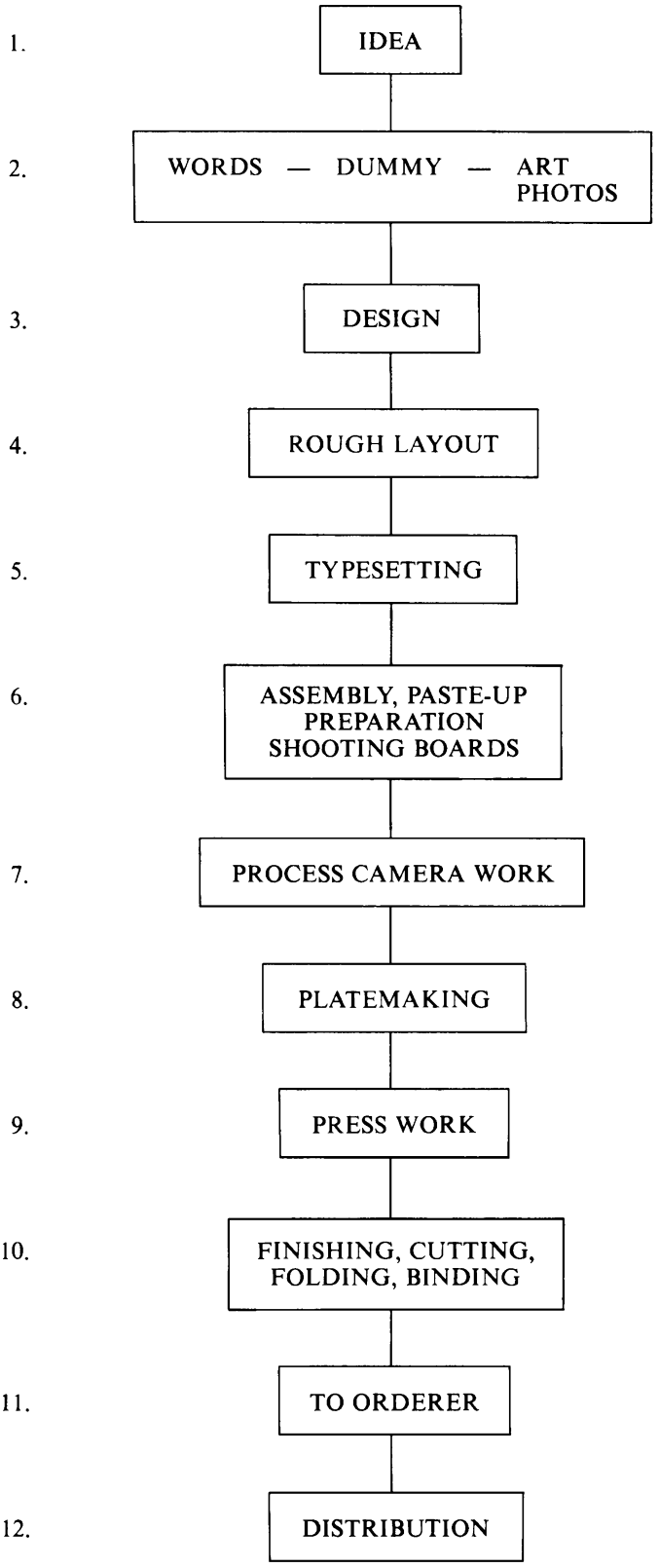

A few years back I found, in a study of the flow lines of promo, that it was very difficult to get a line to move from idea stage to a disseminated piece of promotion.
A study of the graphic arts textbooks on layout being used revealed that they began their org boards and flow lines in the print shop! That’s several notches down the line in the production of effective promo. Omitted was the vital step of design.The textbooks were a printer’s idea of the world and, being printers, they would not really know much about the source of copy or ideas. The book misdefined “dummy” as “rough layout” and misdefined “rough layout” as full design and layout. And that was the text being used. As a result, when requests were made for promo pieces, the reply was, “Well, give us the dummy,” and when the dummy came, it was, “This isn’t the layout.”You can’t start making columns of printing (galleys) without somebody doing a design and dummy. And you can’t do a “rough layout” or any layout at all unless you have a design of what the piece is trying to look like.But there was no design step in the assembly line. Instead the printer was being asked to put together a “layout” when he hadn’t a clue of what the person ordering the piece was trying to present. The result of that could only be hackneyed (trite), bad- looking promo as there was no real design — just type columns and photos.Design is quite a subject; one I happen to know more about than printing, I’m afraid. So to see it omitted in texts explained all. The result, no matter how hard the printer worked, would be apt to be ineffective.Once the real bug and omission was spotted, it was not difficult to get the missing vital functions added in and org boarded correctly to straighten out the scene.We now have a correct and complete assembly line for produced promo which permits a flow to occur from idea onward.

The following definitions correctly describe the functions at each step of the promo assembly line.
IDEA: A concept or notion of something to be done; a plan of action; intention.
DUMMY: A scrap paper expression of the idea. Includes in the same package the written materials or words (called copy), all surveys used, captions, photos and art work.
DESIGN: The artful format that will interest and lead the viewer to involvement in and finally desire to act (to attain, to meet a challenge, to acquire, to achieve, etc.).
ROUGH LAYOUT: The precisely measured pages, spaces, type, croppings, laid out with great mechanical accuracy so that typesetting can begin and separation negatives or blocks that will fit can be made.
TYPESETTING: The act, art or process of setting type for printing.
SHOOTING BOARD LA YOUT: (Includes assembly, paste-up, preparation.) The exact, final arrangement and execution of each page, its type, art and pictures and page arrangement in signatures, ready for the process camera (or in letter press, the press).
CAMERA WORK: Where plates are made and photos or art plates are made. This has a branch line, in color, which comes just before it, of making color separation negatives.
PLATEMAKING: The process of making a thin, flat piece of metal or plastic called a plate, upon which a picture or a page of type is engraved.
PRESS WORK: This is the actual printing.
FINISHING: That which completes or gives a finished appearance to any kind of work. It includes the cutting, collation, folding and binding, stapling or stitching of the printed sheets, to make a finished product.
CUTTING: The trimming or separating of the printed sheets to the specified size.
COLLATION: This is assembly of the printed sheets.
FOLDING: This is doubling or bending the sheets over to the specified form and size, if they are designed to be folded, or if they are to be folded for mailing. It is done by machine or by hand.
STAPLING OR STITCHING: This fastens the sheets together.
BINDING: This fastens the sheets together into a cover (if one is to be used).
PACKAGING: This envelopes or boxes the material.
SHIPPING: This gets the product off to destination.
While many substeps may occur, these are the main steps. Each has its own tech.
If the above steps of dummy, design and rough layout are confused with one another or are tried out of sequence, the final product cannot occur, and if by some bungling does happen, it will be an overt product.
Printers and graphic arts texts hint at a mysterious upper world called “commercial advertising firms.” This is as close as they get to mentioning DESIGN as noted above.
Graphic arts texts confuse “dummy” and “rough layout.” As a result, the industry is in a spin most of the time, as you may have noticed.
The only place the above assembly line backs up is when “rough layout” cannot execute the design due to limitations, inadequate facilities or errors. This requires liaison between these two to iron it all out.
Ignoring or misapplying these flow lines will give you poor promo or, at best, make it hard to get promo out.
The line tangles AT THE TOP THREE POINTS below “idea” unless these are well understood and done exactly in this sequence.
If the DESIGN definition is understood and well used, promo will be effective.
HCOB 30 August 1965, ART and HCOB 29 July 1973, ART, MORE ABOUT are vital if one is going to do promotion. They regulate the first three steps of this line.